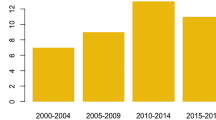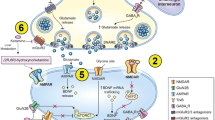Abstract
Purpose
Pregabalin is a gamma-aminobutyric acid (GABA) analogue approved for the treatment of epilepsy, neuropathic pain and generalised anxiety disorder. As a GABA analogue, there has been some concern about an abuse liability. We aimed to investigate the possible abuse liability of pregabalin.
Methods
By applying a Bayesian data-mining algorithm to reports of possible drug abuse or addiction in the Swedish national register of adverse drug reactions (SWEDIS), we calculated the information component (IC) for pregabalin and reports of abuse and addiction.
Results
Out of 198 reports indicative of abuse or addiction to any drug, 16 concerned pregabalin. The IC became significantly elevated in the fourth quarter of 2008, rising to 3.99 (95% confidence interval 3.21–4.59) at the end of 2009.
Conclusion
Based on the signal from the present study, we conclude that pregabalin is likely to be associated with an abuse potential.

Similar content being viewed by others
References
European Medicines Agency (EMA). Lyrica (pregabalin) Scientific Discussion. Available from: http://www.emea.europa.eu/humandocs/Humans/EPAR/lyrica/lyrica.htm. Accessed 5 January 2010
US Label (Lyrica). Available from: http://media.pfizer.com/files/products/uspi_lyrica.pdf. Accessed 5 January 2009
Summary of Product Characteristics (Lyrica). Available from: http://www.emea.europa.eu/humandocs/PDFs/EPAR/lyrica/emea-combined-h546en.pdf. Accessed 5 January 2010
Sundström A, Hallberg P (2009) Data mining in pharmacovigilance—detecting the unexpected: the role of index of suspicion of the reporter. Drug Saf 32(5):419–427
WHO Collaborating Centre for Drug Statistics Methodology. Available from: www.whocc.no. Accessed 10 February 2010
Bate A, Lindquist M, Edwards IR, Olsson S, Orre R, Lansner A, De Freitas RM (1998) A Bayesian neural network for adverse drug signal generation. Eur J Clin Pharmacol 54:315–321
Summary of Product Characteristics (Neurontin). Available from: http://emc.medicines.org.uk/document.aspx?documentId=17095#DOCREVISION. Accessed 5 January 2010
Zvolensky MJ, Schmidt NB (2004) Anxiety and substance use disorders: introduction to the special series. J Anxiety Disord 18(1):1–6
Acknowledgements
No funding source was involved in this study.
Conflicts of interest
None.
Author information
Authors and Affiliations
Corresponding author
Rights and permissions
About this article
Cite this article
Schwan, S., Sundström, A., Stjernberg, E. et al. A signal for an abuse liability for pregabalin—results from the Swedish spontaneous adverse drug reaction reporting system. Eur J Clin Pharmacol 66, 947–953 (2010). https://doi.org/10.1007/s00228-010-0853-y
Received:
Accepted:
Published:
Issue Date:
DOI: https://doi.org/10.1007/s00228-010-0853-y




